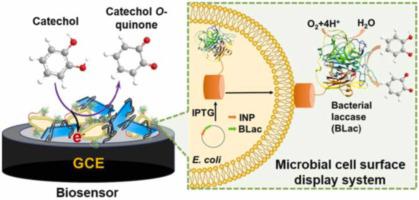Journal of Hazardous Materials ( IF 12.2 ) Pub Date : 2023-03-23 , DOI: 10.1016/j.jhazmat.2023.131265 Yanfang Zhao 1 , Jing Yang 2 , Yuqing Wu 1 , Baojian Huang 1 , Lubin Xu 1 , Jianming Yang 2 , Bo Liang 2 , Lei Han 1

|
Although bacterial laccase (BLac) has many advantages including short fermentation period and adaptable activity to wide temperature and pH ranges, it is of challenge and significance to apply BLac to the biosensors, due to the intracellular secretion and poor electron transfer efficiency of BLac. Here, cell surface-displayed BLac (CSDBLac) was successfully constructed as whole-cell biocatalyst through microbial surface display technology, eliminating the mass transfer restriction and laborious purification steps. Meanwhile, MXenes/polyetherimide-multiwalled carbon nanotubes (MXenes/PEI-MWCNTs) nanohybrids were designed to immobilize CSDBLac and improve their electrochemical activity. Then, an electrochemical biosensor was successfully constructed to detect common phenolic pollutants (catechol and hydroquinone) by the co-immobilization of CSDBLac and MXenes/PEI-MWCNTs nanohybrids onto a glassy carbon electrode. Subsequently, it was successfully applied to the water samples assay with good reliability and repeatability. This work innovatively used BLac and nanohybrid as the core elements of biosensor, which not only effectively solved the application bottleneck of BLac on biosensors, but also dramatically promote the electro transfer efficiency between whole-cell biocatalyst and electrode. This method is of profound meanings for significantly improving the performance of phenolic biosensors and other biosensors from the origin.
中文翻译:

在微生物表面构建细菌漆酶,用于纳米杂化物增强性能的酚类污染物超灵敏生物传感
尽管细菌漆酶(BLac)具有发酵周期短、活性适应温度和pH范围广等诸多优点,但由于BLac为细胞内分泌且电子传递效率低,将其应用于生物传感器具有挑战性和意义。在这里,细胞表面展示的 BLac (CSDBLac) 通过微生物表面展示技术成功构建为全细胞生物催化剂,消除了传质限制和费力的纯化步骤。同时,设计了 MXenes/聚醚酰亚胺-多壁碳纳米管 (MXenes/PEI-MWCNTs) 纳米杂化物来固定 CSDBLac 并提高其电化学活性。然后,通过将 CSDBLac 和 MXenes/PEI-MWCNTs 纳米杂化物共同固定到玻碳电极上,成功构建了电化学生物传感器来检测常见的酚类污染物(儿茶酚和对苯二酚)。随后,它成功应用于水样测定,具有良好的可靠性和重复性。该工作创新性地将BLac和纳米杂化物作为生物传感器的核心元件,不仅有效解决了BLac在生物传感器上的应用瓶颈,而且极大地提升了全细胞生物催化剂与电极之间的电转移效率。该方法对于从源头上显着提高酚类生物传感器和其他生物传感器的性能具有深远的意义。成功应用于水样测定,具有良好的可靠性和重复性。该工作创新性地将BLac和纳米杂化物作为生物传感器的核心元件,不仅有效解决了BLac在生物传感器上的应用瓶颈,而且极大地提升了全细胞生物催化剂与电极之间的电转移效率。该方法对于从源头上显着提高酚类生物传感器和其他生物传感器的性能具有深远的意义。成功应用于水样测定,具有良好的可靠性和重复性。该工作创新性地将BLac和纳米杂化物作为生物传感器的核心元件,不仅有效解决了BLac在生物传感器上的应用瓶颈,而且极大地提升了全细胞生物催化剂与电极之间的电转移效率。该方法对于从源头上显着提高酚类生物传感器和其他生物传感器的性能具有深远的意义。











































 京公网安备 11010802027423号
京公网安备 11010802027423号